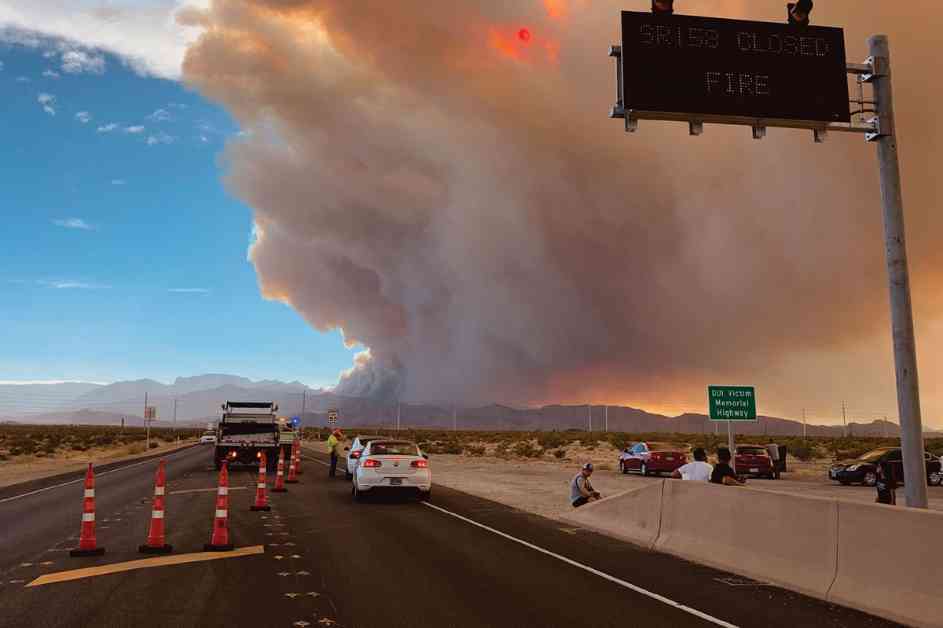Impact of Wildfire Smoke on Air Quality in Southern Nevada: The Role of Climate Change
State Route 158 was closed to Mt. Charleston on June 28, 2020, as intense winds spread what officials later identified as the Mahogany Fire. The wildfire season in Southern Nevada has been particularly intense in recent years, with smoke from these fires significantly affecting the air quality in the region. This has raised concerns among residents and officials, highlighting the need to address the impact of wildfires on air quality and the role of climate change in exacerbating these issues.
The Impact of Wildfire Smoke on Air Quality
The influx of wildfires in Southern Nevada has led to a significant decline in air quality, with smoke frequently enveloping the atmosphere and posing health risks to residents. Kevin MacDonald, the public information administrator for Clark County’s Division of Air Quality, emphasized the importance of issuing a seasonal wildfire smoke advisory alongside the ozone advisory to alert people about the potential risks associated with poor air quality.
In previous years, the influence of wildfire smoke on air quality has been evident, with heavy exceedances for ozone recorded in 2018 and 2021. MacDonald highlighted that more than 5,000 wildfires ravaged California this year, underscoring the impact of climate change on intensifying these natural disasters. As temperatures rise and conditions become drier, wildfires burn longer and more intensely, releasing harmful pollutants into the air.
Ground-level ozone, a key outdoor air quality challenge in Southern Nevada, thrives in hot, sunny environments like Clark County. The geographical features of the region, with mountains creating a ‘bowl’ for pollutants to settle and accumulate, contribute to the formation of ozone. MacDonald noted that in July, there were 15 days that surpassed the ozone standard, marking the worst month in six years for air quality in the area. The American Lung Association also issued Clark County an F grade for high ozone days, highlighting the severity of the situation.
Health Risks and Recommendations
Unhealthy levels of ozone, smoke, and dust in the air pose significant health risks, especially for vulnerable populations such as seniors, children, pets, and individuals with respiratory conditions like COPD or asthma. MacDonald advised residents to take precautions on bad air quality days, including changing air filters, staying indoors, and limiting outdoor activities, particularly in the mornings when pollutants are less concentrated.
Moreover, MacDonald emphasized the need to avoid activities that could further exacerbate air quality issues, such as smoky celebrations involving fireworks. He specifically mentioned gender reveal parties as events where fireworks should be avoided to prevent the release of additional pollutants into the atmosphere. These simple measures can help reduce the impact of wildfires and other sources of air pollution on the region’s air quality.
The Role of Climate Change
Climate change plays a significant role in exacerbating the impact of wildfires on air quality in Southern Nevada. Rising temperatures, drier conditions, and more frequent extreme weather events create ideal conditions for wildfires to spread and intensify. The combination of these factors not only leads to more frequent wildfires but also contributes to the release of harmful pollutants into the air, further compromising air quality in the region.
As the effects of climate change continue to manifest in Southern Nevada and beyond, it is crucial for communities to prioritize environmental sustainability and take proactive measures to mitigate the impact of wildfires and other sources of pollution on air quality. This includes implementing policies to reduce greenhouse gas emissions, promoting renewable energy sources, and investing in wildfire prevention and management strategies to safeguard public health and the environment.
Moving Forward
Addressing the impact of wildfire smoke on air quality in Southern Nevada requires a multi-faceted approach that involves collaboration between government agencies, community organizations, and residents. By raising awareness about the health risks associated with poor air quality, implementing targeted interventions to reduce pollution, and advocating for sustainable environmental practices, we can work towards improving air quality and creating a healthier future for all.
In conclusion, the impact of wildfires on air quality in Southern Nevada underscores the urgent need to address the interconnected challenges of climate change, environmental sustainability, and public health. By taking proactive steps to reduce emissions, mitigate the effects of wildfires, and promote clean air initiatives, we can protect our communities and preserve the natural beauty of our region for generations to come. Let us work together to create a more sustainable and resilient future for Southern Nevada and beyond.



